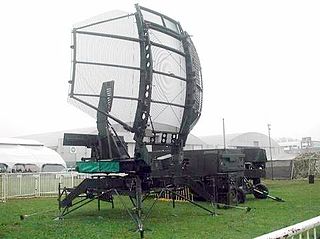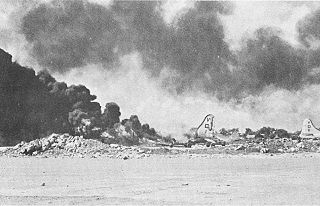
The AN/FPS-117 is an L-band active electronically scanned array (AESA) 3-dimensional air search radar first produced by GE Aerospace in 1980 and now part of Lockheed Martin. The system offers instrumented detection at ranges on the order of 200 to 250 nautical miles and has a wide variety of interference and clutter rejection systems.

The AN/TPS-43 is a transportable air search 3D radar produced in the United States originally by Westinghouse Defense and Electronic Division, which was later purchased by Northrop-Grumman. It is used primarily for early warning and tactical control, often for control over an associated surface-to-air missile battery or airfield. It is designed to be transported in two M35 cargo trucks and easily air-transportable on two pallets.

The AN/TPS-75 is a transportable passive electronically scanned array air search 3D radar produced in the United States. It was originally designated the TPS-43E2. Although the antenna is a radically new design from the TPS-43, the radar van itself, which houses the transmitter, receiver processors, and displays is very similar to the older TPS-43E2. It is produced in the United States originally by Westinghouse Defense and Electronic Division, which was later purchased by Northrop-Grumman.

The 414th Fighter Group is an Air Reserve Component (ARC) of the United States Air Force. It is assigned to the 944th Fighter Wing of Tenth Air Force, Air Force Reserve Command, stationed at Seymour Johnson Air Force Base, North Carolina.

Highlands Air Force Station was a military installation in Middletown Township near the borough of Highlands, New Jersey. The station provided ground-controlled interception radar coverage as part of the Lashup Radar Network and the Semi-Automatic Ground Environment network, as well as providing radar coverage for the Highlands Army Air Defense Site. The site's 240 acres (97 ha) is now the Rocky Point section in Hartshorne Woods Park of the Monmouth County Parks System.
The SAGE radar stations of Air Defense Command were the military installations operated by USAF squadrons using the 1st automated air defense environment and networked by the SAGE System, a computer network. Most of the radar stations used the Burroughs AN/FST-2 Coordinate Data Transmitting Set (CDTS) to automate the operator environment and provide radar tracks to sector command posts at SAGE Direction Centers (DCs), e.g., the Malmstrom Z-124 radar station was co-located with DC-20. The sector/division radar stations were networked by DCs and Manual Control Centers to provide command, control, and coordination for ground-controlled interception of enemy aircraft by interceptors such as the F-106 developed to work with the SAGE System.

The AN/FPS-6 Radar was a long-range height finding radar used by the United States Air Force's Air Defense Command. The AN/FPS-6 radar was introduced into service in the late 1950s and served as the principal height-finder radar for the United States for several decades thereafter. It was also used by the Royal Air Force alongside their AMES Type 80s. Built by General Electric, the S-band radar operated on a frequency of 2700 to 2900 MHz. Between 1953 and 1960, about 450 units of the AN/FPS-6 and the mobile AN/MPS-14 version were produced. The AN/FPS-90 and AN/FPS-116 radars were identical to the AN/FPS-6 except for receiver modifications.

The AN/FPS-7 Radar was a Long Range Search Radar used by the United States Air Force Air Defense Command.

The AN/FPS-20 was a widely used L band early warning and ground-controlled interception radar system employed by the United States Air Force Air Defense Command, the NORAD Pinetree Line in Canada, the USAF CONAD in the continental United States, and a variety of other users. The design started life as the Bendix AN/FPS-3 in 1950, was upgraded to the FPS-20, then spawned over a dozen different variants as additional upgrades were applied. The FPS-20 formed the backbone of the US air defense network through the early Cold War with over 200 units deployed. Most FPS-20 sites were replaced by modern equipment in the late 1960s, although a number were turned over to the FAA, modified for air traffic control use, and became ARSR-60s.

The AN/FPS-4 Radar was a Height-Finder Radar used by the United States Air Force Air Defense Command.
The AN/FPS-18 was a medium-range search Radar used by the United States Air Force Air Defense Command.

The AN/CPS-6 was a medium-range search/height finder Radar used by the United States Air Force Air Defense Command.

During World War II, a series of Japanese air attacks on the Mariana Islands took place between November 1944 and January 1945. These raids targeted United States Army Air Forces (USAAF) bases and sought to disrupt the bombing of Japan by Boeing B-29 Superfortress heavy bombers operating from the islands. The Japanese lost 37 aircraft during this operation, but destroyed 11 B-29s and damaged a further 43. Preparations were also made for commando raids on the bases in early and mid-1945 but these did not go ahead.

Bellefontaine Air Force Station is a closed United States Air Force General Surveillance Radar station. It is located 2.3 miles (3.7 km) east-northeast of Bellefontaine, Ohio. It was closed in 1969.
Port Austin Air Force Station is a closed United States Air Force General Surveillance Radar station. It is located 1.2 miles (1.9 km) south-southwest Port Austin, Michigan. It was closed in 1988 by the Air Force.
Curlew Air Force Station is a closed United States Air Force General Surveillance Radar station. It is located 16 miles (26 km) north of Republic, Washington. It was closed in 1959.

Canadian Forces Station Kamloops is a closed General Surveillance Radar station. It is located 12.8 miles (20.6 km) northeast of Kamloops, British Columbia on the peak of Mount Lolo. It was closed in 1988 due to advances in military technology which made it obsolete.
The Lashup Radar Network was a United States Cold War radar netting system for air defense surveillance which followed the post-World War II "five-station radar net" and preceded the "high Priority Permanent System". ROTOR was a similar expedient system in the United Kingdom.
The Permanent System was a 1950s radar network used for the CONUS "manual air defense system" and which had a USAF aircraft control and warning (AC&W) organization of personnel and military installations with radars to allow Air Defense Command ground-controlled interception of Cold War bombers attacking the United States.

AN/SPS-6 is a two-dimensional radar manufactured by Bendix and Westinghouse Electric. It was used by the US Navy as a first-generation air-search radar after World War II, and was widely exported to allies. In addition, the improved AN/SPS-12 is the derivative types developed in other countries.
















